
Shiv Parivar Tanjore Painting
Shiv Parivar Tanjore painting is a traditional style of painting that originated in Tanjore, Tamil Nadu, India. It depicts the divine family of Lord Shiva, also known as the Shiv Parivar. The painting usually features Lord Shiva, his consort Goddess Parvati, their sons Lord Ganesha and Lord Kartikeya, and the vehicle of Lord Shiva, Nandi the bull.
Tanjore paintings are known for their rich and vibrant colors, intricate detailing, and the use of gold foils and precious stones.
Shiv Parivar Tanjore paintings are considered auspicious and are often used for worship and decoration in Hindu households. They are also popular as gifting items for special occasions and festivals. These paintings not only showcase the divinity of Lord Shiva and his family but also represent the rich cultural heritage of the Tanjore region.
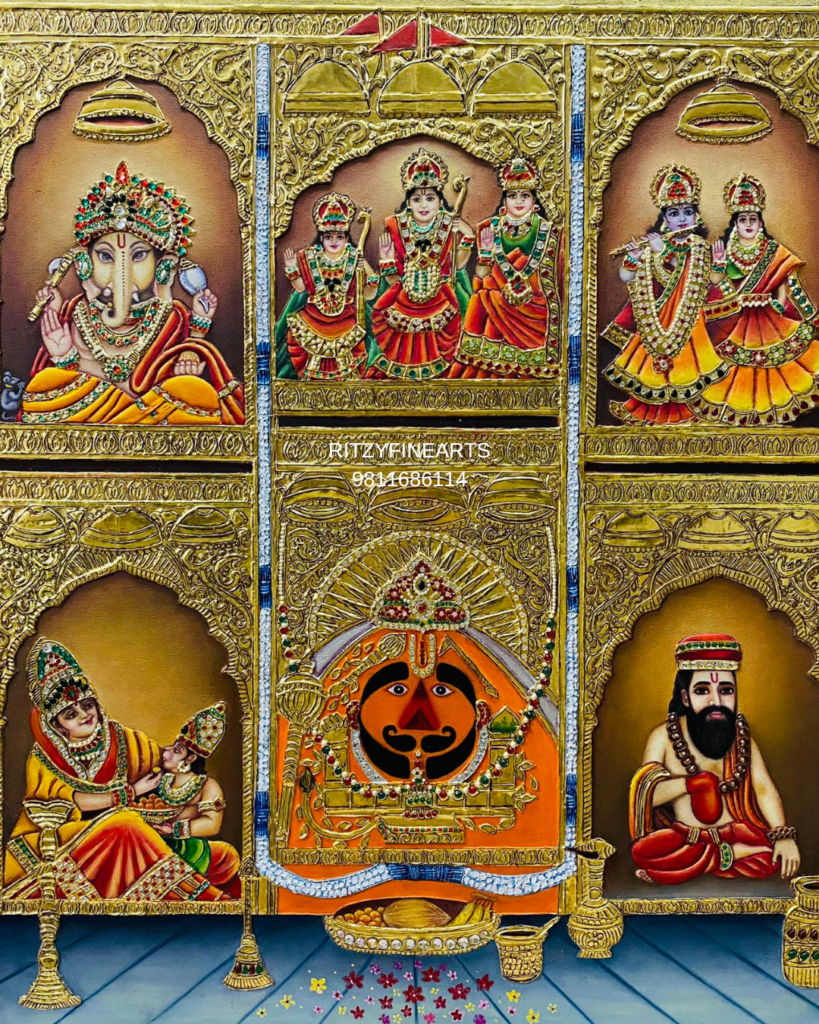
Salasar Balaji Tanjore Painting
Salasar Balaji is a famous Hindu temple dedicated to Lord Hanuman, located in the town of Salasar in the Churu district of Rajasthan, India. The temple is considered to be a significant pilgrimage site for devotees of Lord Hanuman and receives a large number of visitors every year.
A “Salasar Balaji Tanjore painting” could refer to a Tanjore-style painting that features the deity Lord Hanuman as worshipped in the Salasar Balaji temple. Such a painting might showcase Lord Hanuman in a traditional Tanjore style, with intricate jewelry, vibrant colors, and possibly adorned with gold leaf or precious stones to emphasize the divine nature of the deity.
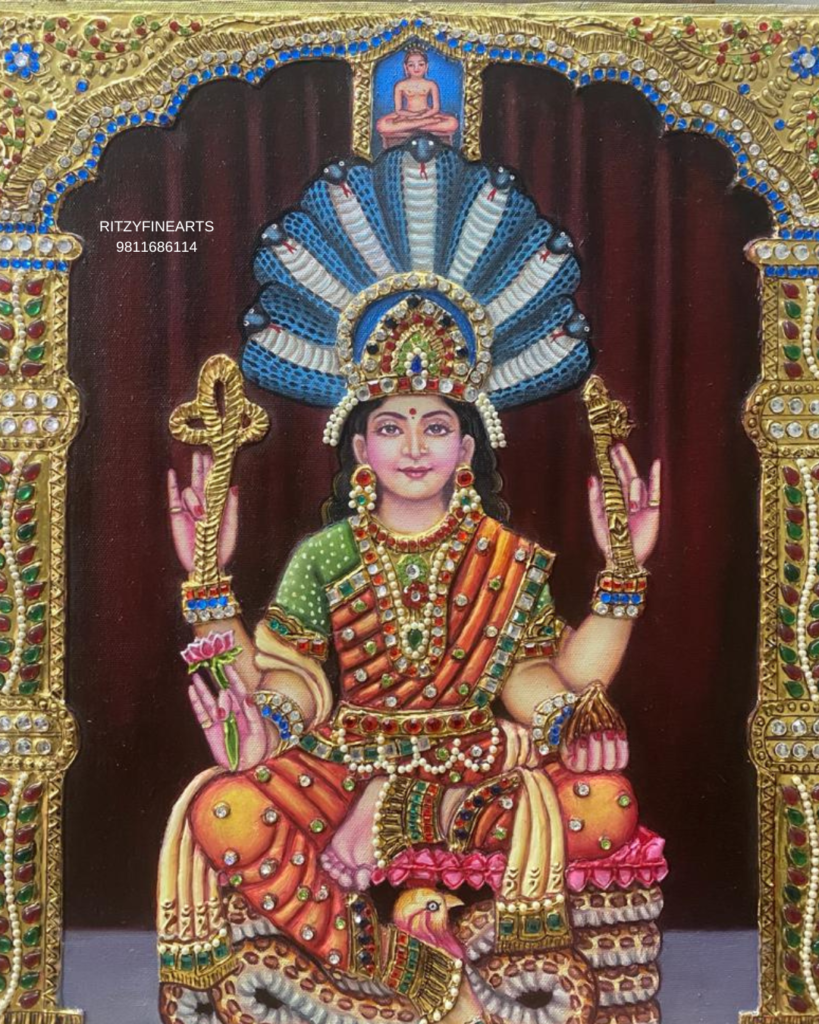
PADMAVATI MATA TANJORE PAINTING
A Padmavati Mata Tanjore painting would likely depict the goddess Padmavati in the traditional Tanjore painting style. Padmavati Mata is a Hindu goddess related to Jainism & is often considered to be a form of Goddess Lakshmi, the goddess of wealth and prosperity.
The central focus of the painting would be the image of Goddess Padmavati. She might be depicted seated on a lotus or in a graceful pose, adorned with jewelry and traditional attire.
Tanjore paintings are known for their intricate detailing, vibrant colors, and use of materials like gold leaf and precious stones to adorn the artwork.

Guruji tanjore painting
A “Guruji Tanjore painting” likely refers to a Tanjore-style painting . Tanjore paintings are a traditional art form that originated in the town of Thanjavur (Tanjore) in Tamil Nadu, India.
These paintings are characterized by their use of vibrant colors, intricate detailing, and embellishments with materials like gold leaf and precious stones.
The central figure of Guruji Bade Mandir Blessings are believed to have the power to bring about positive transformations, inner growth, and a sense of connection with higher consciousness or even through thoughts and prayers.
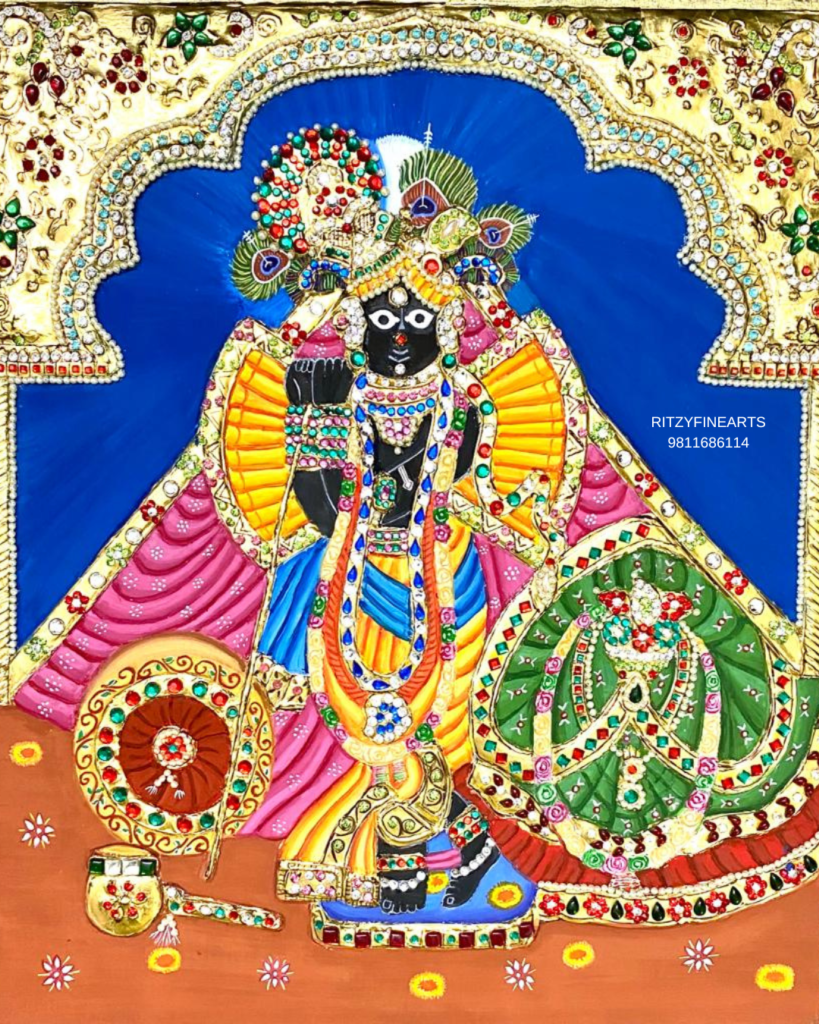
Banke Bihari Ji tanjore painting
A Banke Bihari Tanjore painting depicting the deity Banke Bihari, who is a beloved form of Lord Krishna in Hinduism. Banke Bihari is a popular deity worshipped primarily in the town of Vrindavan, India. Tanjore paintings are a traditional art form that originated in the town of Thanjavur (Tanjore) in Tamil Nadu, India.
The central figure of the painting would be Lord Banke Bihari, often depicted as a playful and charming form of Lord Krishna. He might be shown in a standing pose, adorned with traditional clothing, jewelry, and accessories.
Tanjore paintings are characterized by their intricate detailing. You can expect to see fine work on the deity’s attire, facial features, jewelry, and other elements.

Raas leela Tanjore Painting
A Raas Leela Tanjore painting that depicts the divine dance of Lord Krishna known as the “Raas Leela.” Raas Leela is a significant episode from Hindu mythology, where Lord Krishna is depicted dancing with the Gopis (cowherd girls) in the moonlit night of Vrindavan.
The central focus of the painting would be Lord Krishna surrounded by the Gopis. Krishna might be depicted in his iconic blue-skinned form, and the Gopis might be shown in traditional attire.
Dance and Movement: The painting would likely capture the dynamic and graceful movements of the dance. The figures might be shown in various poses and expressions that convey the joy and devotion of the moment.
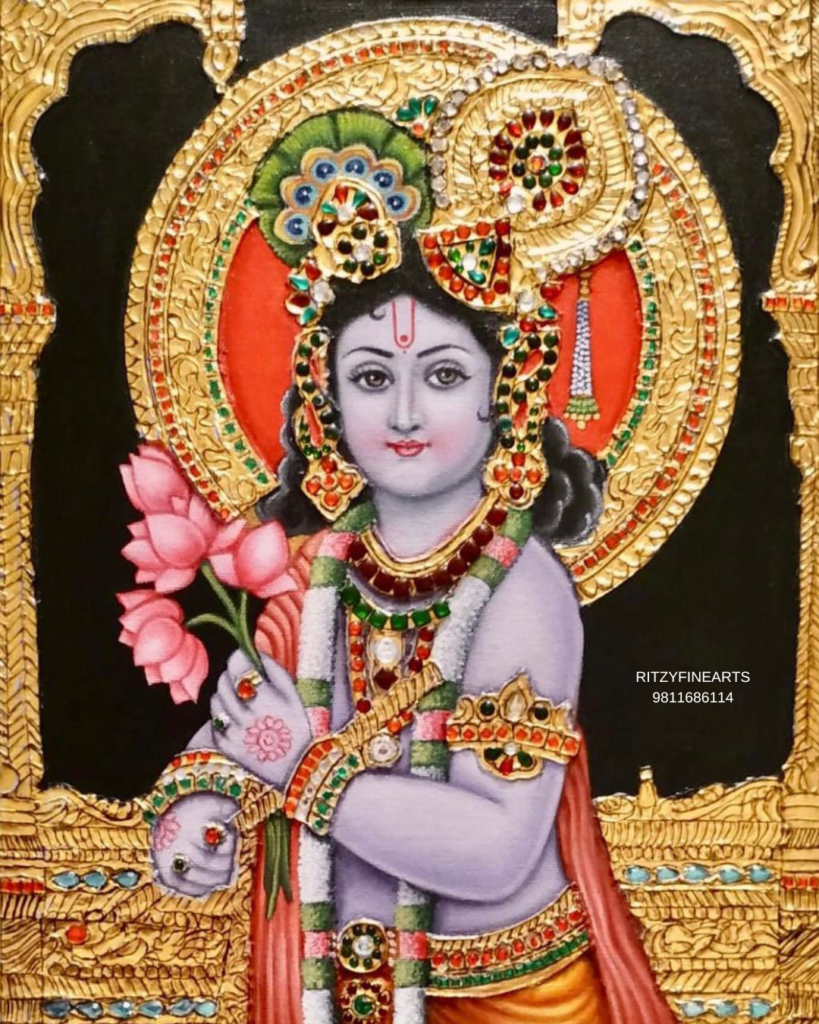
KRISHNA TANJORE PAINTING
Krishna Tanjore painting, also known as Tanjore or Thanjavur painting, is a classical South Indian art form that originates from the town of Thanjavur (Tanjore) in the state of Tamil Nadu, India. These paintings are known for their rich colors, intricate details, and the use of gold foils and precious stones, which give them a distinct and vibrant appearance.
The subject of Krishna Tanjore paintings is often inspired by Hindu mythology and religious themes, with Lord Krishna being a popular choice.
These paintings typically depict various episodes from Krishna’s life, such as his childhood antics, interactions with his devotees, and romantic episodes like his dance with the gopis.
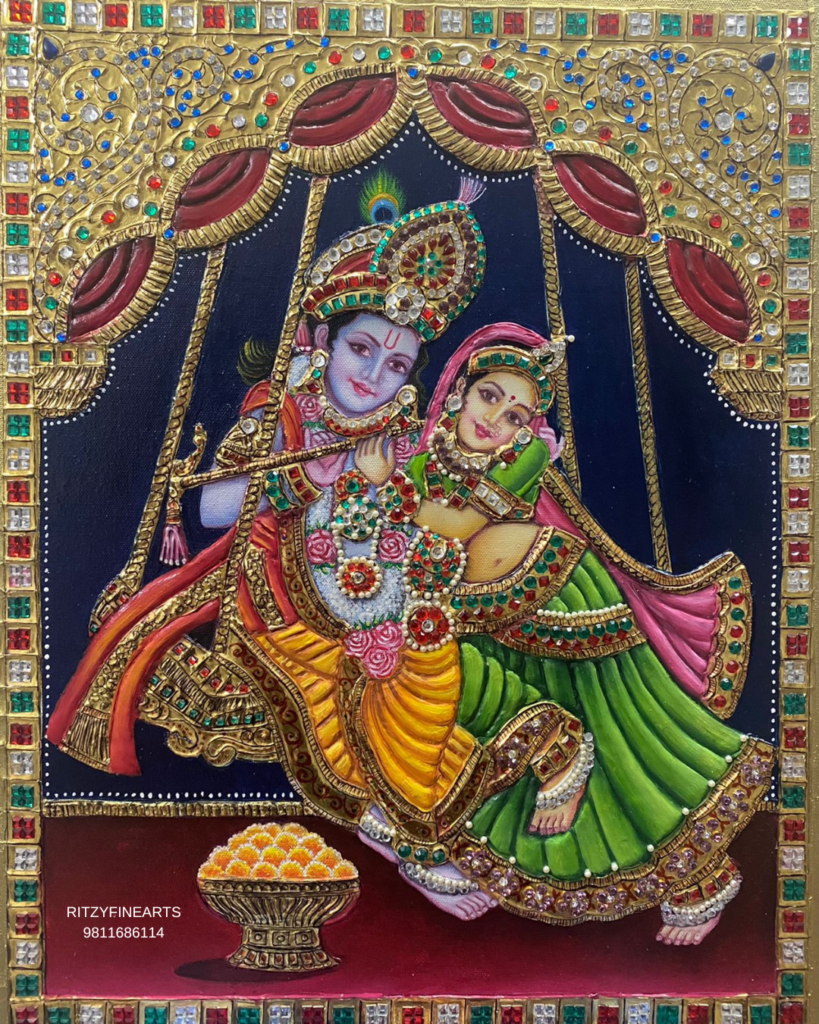
RADHA KRISHNA TANJORE PAINTING
A Radha Krishna Tanjore painting is a specific type of Tanjore painting that depicts the divine love story between Lord Krishna and his beloved Radha, a central theme in Hindu mythology and devotion. Like other Tanjore paintings, these artworks are known for their intricate detailing, vibrant colors, and use of gold foil and precious stones to enhance their beauty and divine aura.
The main focus of the painting is, of course, the divine couple, Radha and Krishna. Radha is often depicted as a beautiful and devoted maiden, while Krishna is portrayed as a charming and divine youth.
Radha Krishna Tanjore paintings are often created as a form of devotional art and are used to inspire spiritual contemplation and devotion among viewers. They can be found in homes, temples, and art galleries, serving as a visual representation of the deep and eternal love shared between Radha and Krishna.

Bal GOPAL KRISHNA TANJORE PAINTING
A “Bal Gopal” Krishna Tanjore painting is a variation of Tanjore painting that specifically focuses on depicting the childhood or youthful form of Lord Krishna, often referred to as “Bal Gopal.” This form of Krishna is typically portrayed as an adorable and mischievous child, engaging in various playful activities from his early life.
The central theme of these paintings is the innocent and playful nature of Lord Krishna during his childhood.
He might be shown crawling, standing, dancing, or engaged in other charming activities. Bal Gopal Krishna Tanjore paintings often feature bright and joyful colors to capture the vibrancy and cheerfulness of Krishna’s childhood
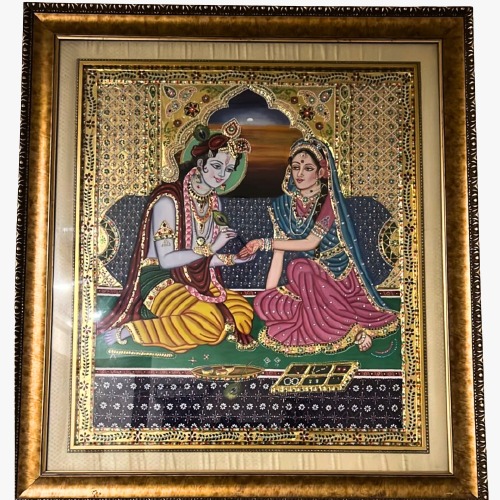
RADHA KRISHNA TANJORE PAINTING
The painting portrays the profound love and devotion shared between Radha and Krishna. Their relationship is often seen as the embodiment of the union between the human soul (Radha) and the divine (Krishna).
Expressive Faces: The facial expressions of Radha and Krishna are meticulously painted to convey their emotions and the intensity of their love for each other.
Vibrant Colors: The painting typically uses a rich and vibrant color palette, with bold and vivid colors that draw attention and create a visually striking image.
Devotional Symbolism: Radha and Krishna are not just characters in a story; they hold deep spiritual significance. Radha symbolizes the soul’s longing for divine union, and Krishna represents the divine itself.
Romantic Scenes: The painting might depict various romantic scenes from the lives of Radha and Krishna, such as their playful interactions, Krishna playing the flute, or their moments of separation and reunion.
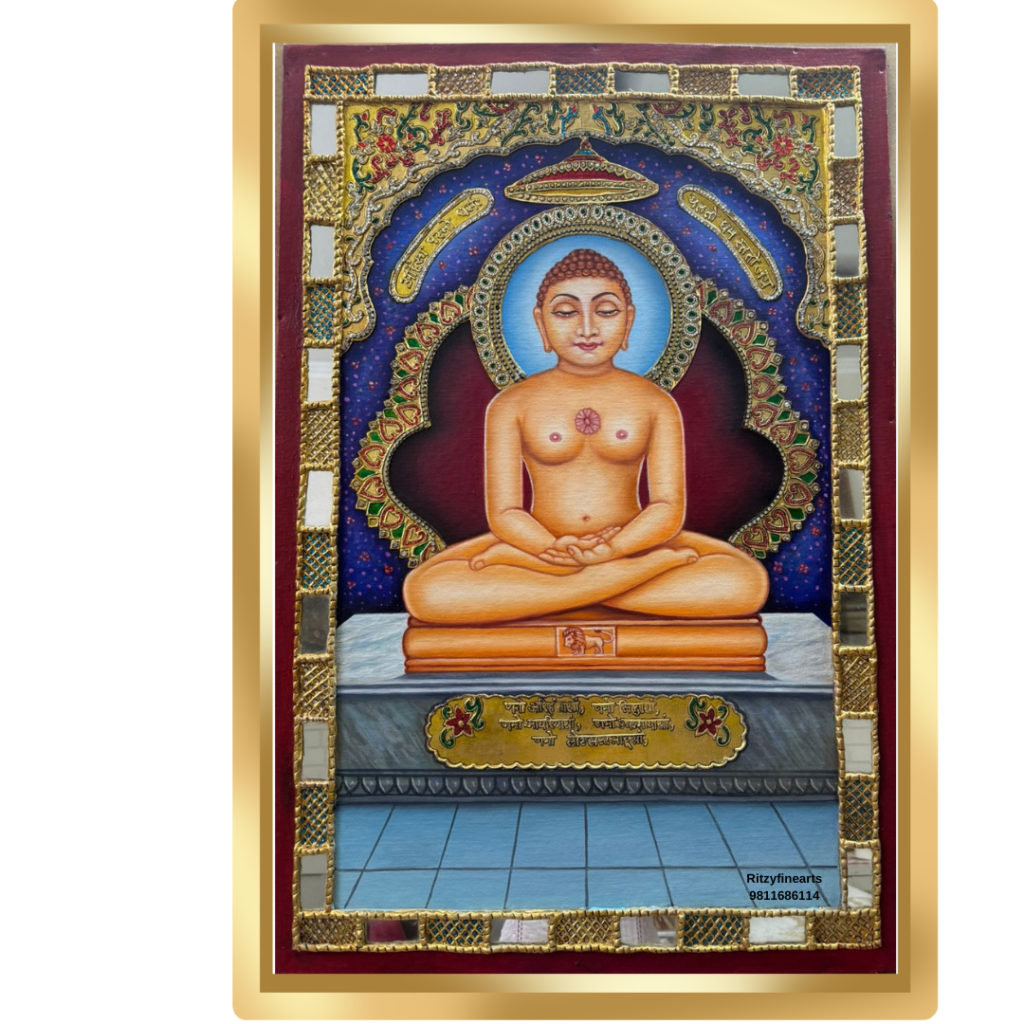
MAHAVIR JI PAINTING
Tanjore paintings, originating from the town of Thanjavur in Tamil Nadu, India, are renowned for their rich colors, surface richness, compact composition, and glittering gold foils. Dating back to the 16th century, these paintings flourished under the patronage of the Maratha rulers of Thanjavur and have since become a significant part of South Indian art heritage.
**Vibrant Colors and Gold Foil**: These paintings typically use vivid hues, with generous use of 22-carat gold foils to highlight certain aspects, giving the artwork a three-dimensional effect and a regal look.
***Intricate Detailing**: The depiction of Mahavir Ji is marked by intricate detailing, including finely painted features, elaborate jewelry, and meticulously crafted clothing.
**Sacred Symbols**: Often, the paintings include symbols associated with Mahavir Ji, such as the lion, his emblem, and the lotus, representing purity and enlightenment.
***Divine Aura**: The central figure of Mahavir Ji is usually portrayed seated in a meditative posture, exuding a sense of calm and divinity, surrounded by ornamental arches and sanctified spaces.
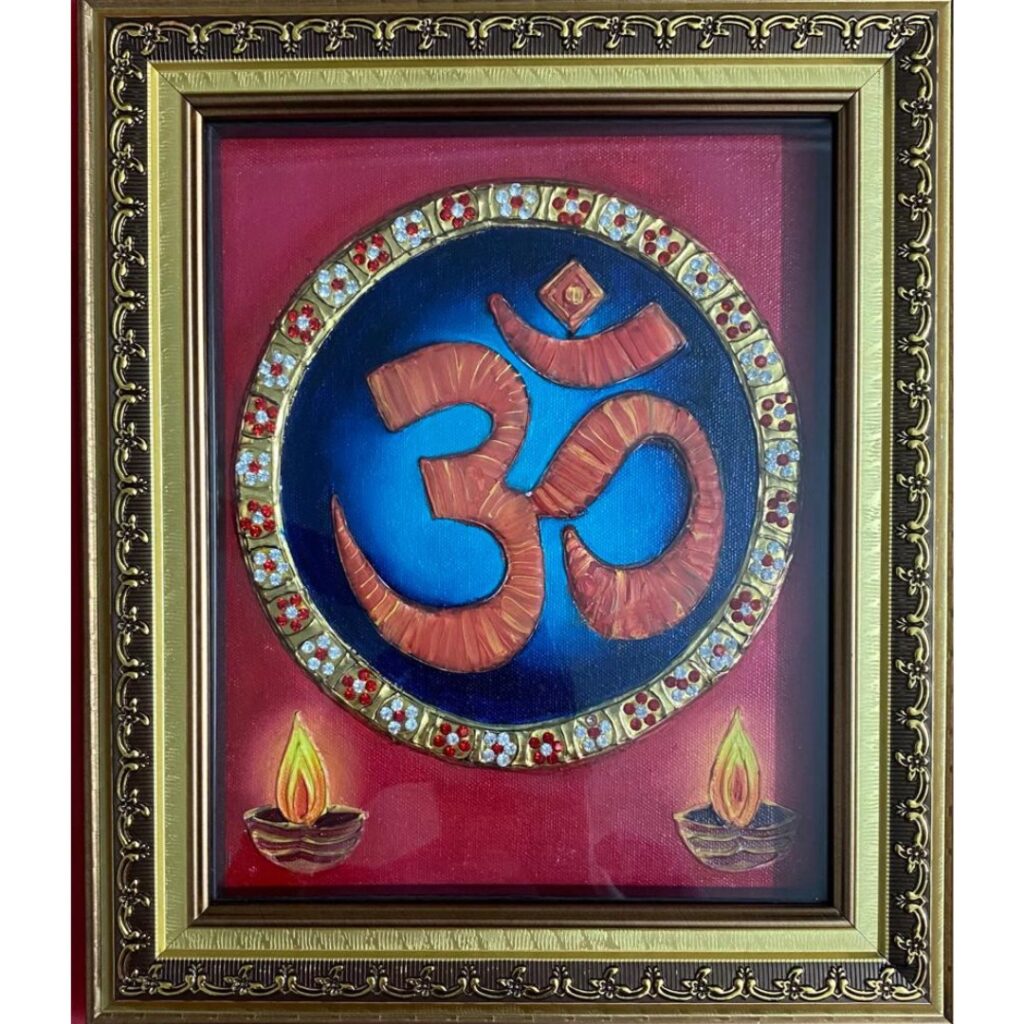
OM TANJORE PAINTING
Om Tanjore painting is a variant of Tanjore painting that features the sacred symbol “Om” (also spelled “Aum”). Om is a significant spiritual symbol in Hinduism, Buddhism, Jainism, and other Indian religions. It represents the essence of the ultimate reality, encompassing creation, existence, and dissolution
Om Symbol: The central element of the painting is the Om symbol (ॐ), which consists of three Sanskrit letters: A, U, and M. The symbol is often depicted in a visually appealing and decorative manner.
Decorative Embellishments: Tanjore paintings are known for their intricate and decorative style. The Om symbol might be surrounded by elaborate borders, motifs, and other decorative elements characteristic of Tanjore art.
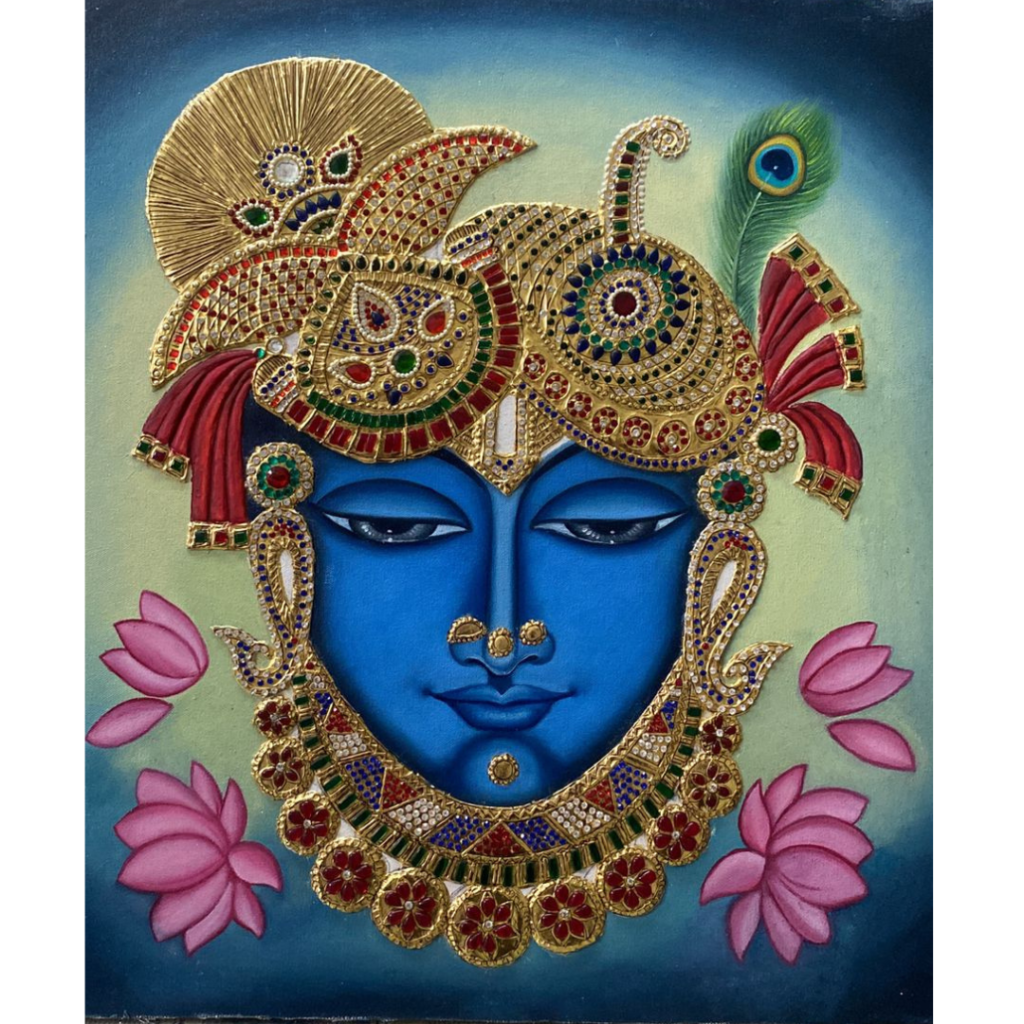

KRISHNA Face PAINTING
-
Vibrant Colors: The use of bright and lively colors is a hallmark of Tanjore paintings, bringing the divine persona of Krishna to life.
-
Gold Foil Detailing: The extensive use of gold foil adds a regal and luminous quality to the paintings, highlighting Krishna’s divinity and grandeur.
-
Intricate Details: Fine detailing in the jewelry, clothing, and background elements makes each painting a detailed work of art.
-
Divine Expressions: The expressions on Krishna’s face are painted with great care, capturing his divine and benevolent nature.
mahavir Ji tanjore painting
Tanjore paintings, originating from the town of Thanjavur in Tamil Nadu, India, are renowned for their rich colors, surface richness, compact composition, and glittering gold foils. Dating back to the 16th century, these paintings flourished under the patronage of the Maratha rulers of Thanjavur and have since become a significant part of South Indian art heritage.
**Vibrant Colors and Gold Foil**: These paintings typically use vivid hues, with generous use of 22-carat gold foils to highlight certain aspects, giving the artwork a three-dimensional effect and a regal look.
***Intricate Detailing**: The depiction of Mahavir Ji is marked by intricate detailing, including finely painted features, elaborate jewelry, and meticulously crafted clothing.
